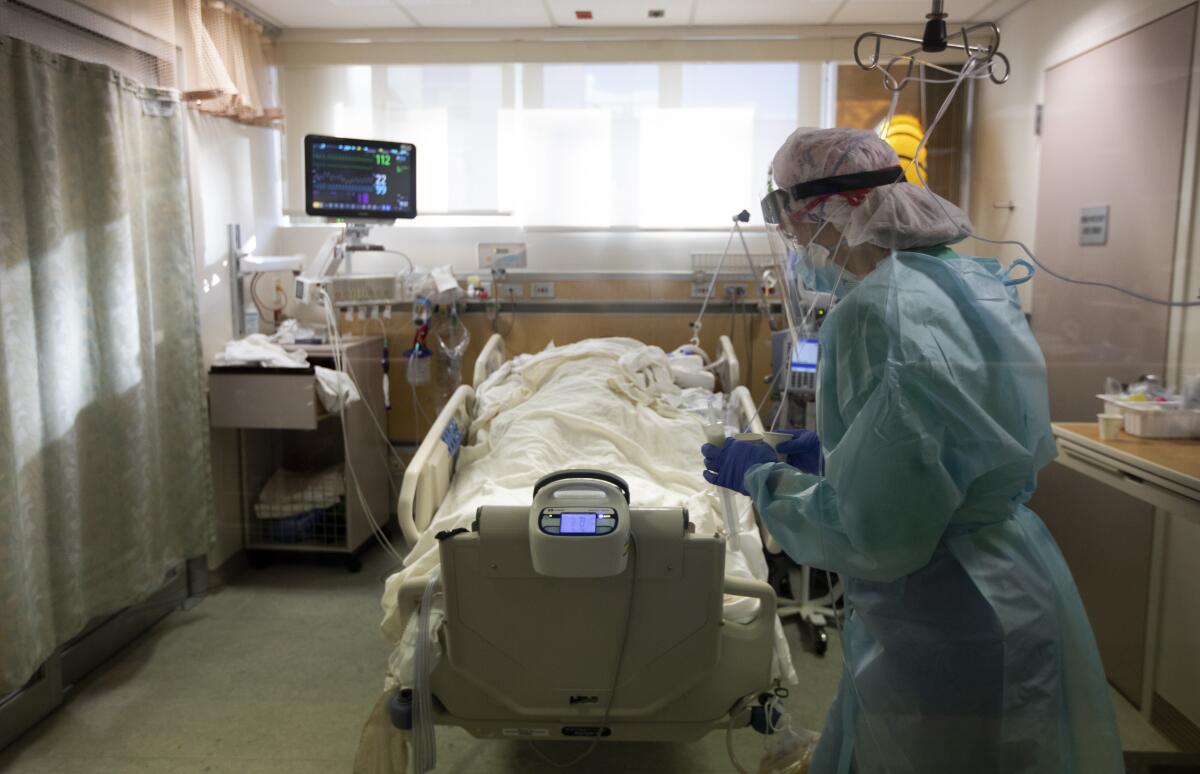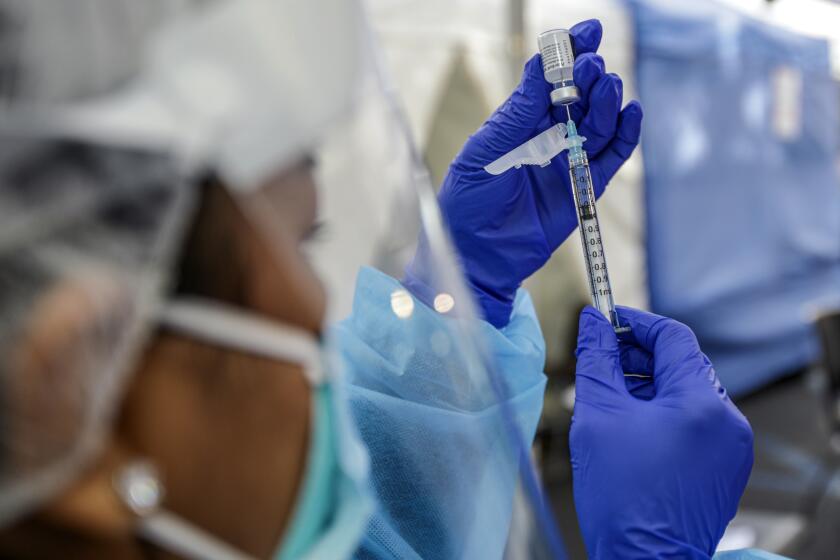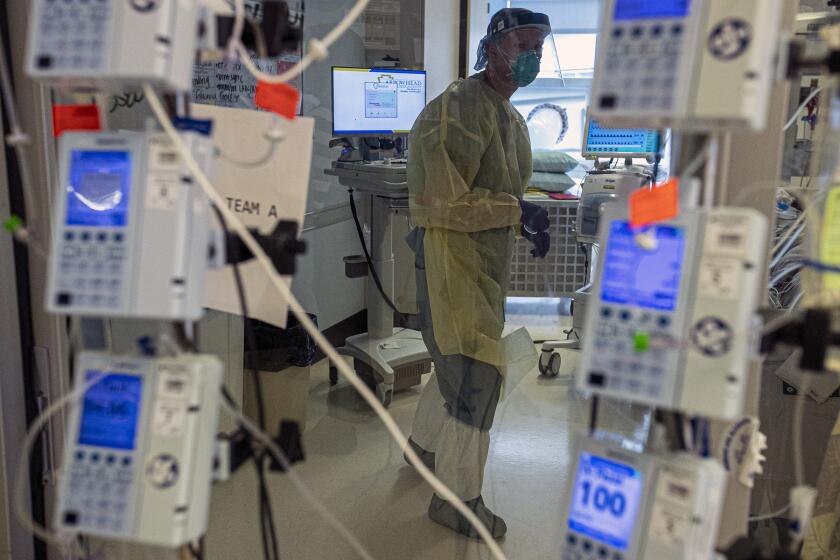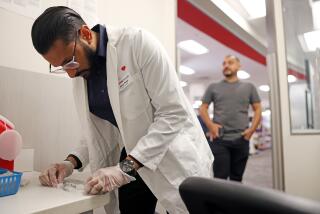Dangerous new coronavirus strains may incubate in COVID-19’s sickest

- Share via
Among the 100 million people around the world who have battled coronavirus infections, scientists are turning to the case of a 45-year-old COVID-19 patient in Boston to understand how the virus is able to outwit humans.
During his 154-day illness — one of the longest on record — the patient’s body became a crucible of riotous viral mutation. He offered the world one of the first sightings of a key mutation in the virus’ spike protein that set off alarm bells when it was later found in strains in the United Kingdom, South Africa and Brazil.
In the U.K. strain, the genetic change known as N501Y is thought to help enhance the virus’ transmissibility by about 50%. In the South Africa strain, it may reduce the effectiveness of COVID-19 vaccines and treatments. Tests of its effect on the Brazil variant are still in progress.
The Boston patient is now being viewed as an important harbinger of the coronavirus’ ability to spin off new and more dangerous versions of itself. Though he died over the summer, the medical file he left behind is helping experts anticipate the emergence of new strains by focusing on the role of a growing population of patients with compromised immune systems who battle the virus for months.
Among the sickest of COVID-19 patients, this population of “long haulers” appears to play a key role in incubating new variants of the coronavirus, some of which could change the trajectory of the pandemic.
The mutations that arose from this single patient are “a microcosm of the viral evolution we’re seeing globally,” said Dr. Jonathan Z. Li, an infectious-disease specialist at Brigham and Women’s Hospital in Boston who treated him. “He showed us what could happen” when a germ with a knack for genetic shape-shifting stumbles upon conditions that reward it for doing so.
Indeed, situations in which patients can’t clear a viral infection are “the worst possible scenario for developing mutations,” said Dr. Bruce Walker, an immunologist and founding director of the Ragon Institute in Boston.
As weeks of illness turn into months, a virus copies itself millions of times. Each copy is an opportunity to make random mistakes. As it spins off new mutations, the virus may happen upon ones that help it resist medications, evade the immune system and come back stronger.
SARS-CoV-2, the coronavirus that causes COVID-19, has been an unpredictable adversary. The chance to witness its transformation in near-real time, and see where and how it mutates in a single host, can guide the design of vaccines and medications that don’t lose their effectiveness over time, Walker said.
Researchers once believed t would take months or even years for the virus to develop resistance to vaccines. The speedy evolution is largely a result of the virus’ unchecked spread.
COVID-19 patients were just beginning to fill the beds of Brigham and Women’s Hospital in the spring of 2020, when the Boston patient was first admitted. He had a fever, nausea, and a CT of his lungs that bore the hallmark “ground glass” appearance of the new disease, said Li, who was part of a team that detailed the man’s case in the New England Journal of Medicine.
But COVID-19 was just one of his challenges. For 22 years, he suffered from a rare disorder called antiphospholipid syndrome, which caused his immune system to attack his own organs and spawn dangerous blood clots throughout his body.
To keep his rogue immune system from killing him, the patient required an arsenal of immunosuppressive drugs. But in his fight against the coronavirus, those medicines kept the patient’s punching arm tied behind his back.
The Boston patient tested positive for SARS-CoV2 infections four separate times over 22 weeks. He was admitted to the hospital six times, including stints in intensive care. Doctors treated him with three courses of the antiviral medication remdesivir and once with Regeneron’s experimental cocktail of monoclonal antibodies.
Swabs taken from his nose and throat during his second hospital stay provided the first hint of the virus’ startling pace of genetic transformation: Compared with a sample taken during his first hospitalization, 11 letters in the coronavirus’ 30,000-letter sequence had flipped, and nine such nucleotides had dropped out.
His next trip to the hospital landed him in the ICU. Tests revealed that 10 more letters in the virus’ genetic code had changed and that one more had been deleted in a period of just five weeks. Three weeks later, after he had seemed to recover, he tested positive again and was put on a mechanical ventilator to help him breathe. This time, researchers found 11 more letter changes and 24 more deletions in the virus’ genome.
Scientists couldn’t say whether the Boston patient was failing to kick the virus or whether it was changing so completely that his immune system couldn’t recognize it.
Health officials set aside carefully considered plans for rolling out COVID-19 vaccines and made the shots widely available. That may hasten the pandemic’s end.
One thing was clear: More than half of the alterations occurred in a stretch of genetic code that dictates the structure of the virus’ spike protein, the protuberance that latches onto human cells and initiates an infection. The virus’ “receptor binding domain” — essentially the key that picks the lock on a human cell — accounts for only 2% of the virus’ genetic code. But 38% of the mutations spun off during the Boston patient’s prolonged illness were concentrated in just that spot.
In late December, British scientists speculated that just such a scenario involving an immunocompromised patient somewhere in England may have spawned the mutations that distinguish the U.K. strain.
Walker said he fears there are many more such patients out there, including people with untreated HIV infections. Immunocompromised by HIV, sick with COVID-19 and given drugs that reward SARS-CoV-2 for devising “escape” mutations, such people could become crucibles of viral mutation.
Scientists in South Africa share that anxiety.
“In South Africa, the country with the world’s biggest HIV epidemic, one concern has been the prolonged viral replication and intra-host evolution in the context of HIV infection,” wrote the authors of a preliminary study that alerted the world to the new variant in early December.

So far, there’s no evidence that patients with HIV are more prone to long-lasting cases of COVID-19. And even if they were, a lengthy chain of immunocompromised patients probably would have been necessary to generate the numerous mutations that distinguish the South Africa strain, its discoverers said.
Scientists are still trying to understand how certain mutations like N501Y have cropped up in so many places at once. Has the mushrooming scale of the pandemic given the virus too many opportunities to alter itself? Or are these mutations arising in a small number of people, like the Boston patient, and then somehow hitching a ride around the world?
Both factors are probably at work, and the longer and hotter the pandemic rages, the more chances the virus will have to devise random mutations.
The Boston patient shows why that can be so dangerous. In his case, the stretches of genetic code that were most prone to change affected structures that COVID-19 vaccines and drugs are designed to recognize. Now there are hints that the changes could undermine the value of those remedies.
California scientists have discovered a new coronavirus strain that appears to be propagating faster than any other variant in the Golden State.
Tulio de Oliveira, an infectious-disease researcher at South Africa’s University of KwaZulu-Natal, sees a pattern in which uncontrolled spread and long-haul infections work in tandem to fuel coronavirus mutations.
Many of the places where new variants have been identified — including South Africa, Britain and California — experienced two waves of outbreaks divided by just a few months. That, De Oliveira suspects, is no mere coincidence.
In the first wave, he said, the proliferation of infections gives the virus ample opportunity to take on genetic changes that may live on in bodies of immunocompromised patients. By the time a second wave begins, novel variants that were incubating in these long-haulers have also begun to circulate. When they encounter vast numbers of new hosts, the result is a fertile environment for strains to establish themselves — if their genetic modifications confer some advantage.
The best way to prevent the emergence of more mutations is to both expand vaccinations and do more to protect people with compromised immune systems, De Oliveira said.
“If we keep the virus around for a long time, we will be giving it more opportunities to outsmart us,” he said.
Dr. Patrick Soon-Shiong, executive chairman of the Times, examines the pandemic’s latest threat: a second wave of global infections fueled by mutations to the virus.










